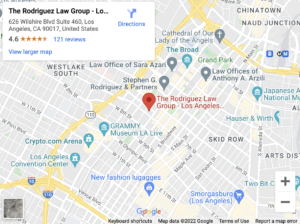East LA Jail
 The Los Angeles County Sheriff’s Department (LASD) operates the nation’s largest jail system. In 2019, the system held over 17,000 inmates, nearly double the population of the country’s second-largest system. In the third quarter of 2023, the average daily population was just over 12,800, substantially lower than before but still higher than any other U.S. jail system.
The Los Angeles County Sheriff’s Department (LASD) operates the nation’s largest jail system. In 2019, the system held over 17,000 inmates, nearly double the population of the country’s second-largest system. In the third quarter of 2023, the average daily population was just over 12,800, substantially lower than before but still higher than any other U.S. jail system.
LASD holds most of these inmates in seven main facilities, although it has transferred many inmates from one of these facilities as it shuts down. Separate from these main facilities, LASD operates dozens of temporary holding facilities at its patrol stations. The East Los Angeles Sheriff’s Station is one of LASD’s most notorious patrol stations and jails.
Where Is the East LA Jail?
 The East LA jail is a temporary holding facility at the East LA Sheriff’s Station. It is located on 3rd St. between Woods Ave. and Civic Center Way. It’s near the East Los Angeles Courthouse. The station has a small parking lot with an entrance on 3rd St. Because of a barrier in the center of 3rd St., you can only enter it from the westbound lanes.
The East LA jail is a temporary holding facility at the East LA Sheriff’s Station. It is located on 3rd St. between Woods Ave. and Civic Center Way. It’s near the East Los Angeles Courthouse. The station has a small parking lot with an entrance on 3rd St. Because of a barrier in the center of 3rd St., you can only enter it from the westbound lanes.
The East LA County Courthouse Parking Structure is within walking distance of the sheriff’s station if the parking lot is full. The East LA jail is also accessible using the Metro E Line because of its proximity to the East LA Civic Center Station.
Who Goes To the East LA Jail?
The East LA Sheriff’s Station serves unincorporated communities in east Los Angeles County, including:
- Belvedere Gardens
- City Terrace
- Eastmont
- East Los Angeles
- Saybrook Park
- Union Pacific
LASD also contracts with nearby cities to provide policing and jail services.
The following communities use LASD to patrol and respond to service calls:
- City of Commerce
- Cudahy
- Maywood
Anyone arrested by LASD in these locations will end up in the East LA jail. Since these areas have no local police department, LASD enforces all local and state laws. There are several crimes for which LASD might arrest someone.
Violent Crimes
According to LASD’s quarterly report, the most common charges against inmates of the LASD jail system involve crimes against people.
Some examples of these offenses include:
- Homicide
- Assault
- Armed robbery
- Kidnapping
- Domestic battery
- Child abuse
Violent crimes are not the most common crimes committed in the East LA patrol area. But these crimes are the most likely to result in detention, according to LASD statistics.
Property Crimes
Property crimes are the second most common charges to result in detention.
Property crimes include:
Property crimes also include white-collar crimes like fraud and embezzlement. Even though property crimes do not involve any injury or threat of injury, LASD can arrest and detain those who commit them.
Sex Crimes
Sex crimes fall far behind violent and property crimes among charges against LASD jail inmates. But they still make up the third most common reason for detaining people in LA County.
These crimes include:
- Rape
- Sexual assault
- Child molestation
- Statutory rape
- Possession or distribution of child pornography
- Pimping, pandering, and prostitution
Although not necessarily a sex crime, deputies can also arrest and detain someone previously convicted of a sex crime who failed to register as a sex offender. This arrest could result in new charges.
Traffic Code Violations
Most violations of California’s vehicle code will result in a traffic citation but not an arrest. The most common traffic violation that will lead to an arrest is DUI. When a person drives under the influence of drugs or alcohol, the deputy will usually take them into custody rather than returning them to the roads.
How Do Arrests Typically Happen?
Arrests in East LA usually happen in three ways. First, officers can arrest someone without an arrest warrant if they have probable cause to believe they committed a crime. This belief comes from the totality of the circumstances, including witness statements, evidence gathered at the crime scene, and the officers’ observations.
For example, suppose 911 operators receive a domestic violence call. They dispatch sheriff’s deputies to the address. The deputies talk to neighbors who report hearing a fight. At the house, they interview a spouse with a cut forehead and another who appears intoxicated. Based on their investigation, deputies might arrest one of them.
Second, patrol officers arrest many people for outstanding warrants in LA County or other jurisdictions. In many cases, the person gets stopped for a minor traffic infraction or has other contact with LASD for a non-arrestable offense, but LASD finds an outstanding warrant when the deputy runs the person’s ID.
A bench warrant for a failure to appear in court authorizes LASD to take the person into custody and hold them until they see a judge.
Third, detectives can arrest someone identified on a search warrant. Sometimes, patrol officers cannot solve a crime at the scene. Detectives take over the case and gather additional evidence to support an arrest. A judge issues a warrant based on a probable cause affidavit.
Thus, suppose someone’s house was burglarized. Officers respond but pass the case to detectives, who gather shoe prints, fingerprints, and hair at the scene. After the lab completes a forensic analysis, the detectives go to a judge for an arrest warrant.
What Happens After Arrest?
The East LA jail only temporarily holds arrestees. The jail only holds 33 inmates, and they are typically held for only 48 hours, exclusive of holidays and weekends. In other words, inmates typically only spend a night or two in jail before heading to court for arraignment and a bail hearing. At the bail hearing, one of three events happens.
Release on Recognizance
Under California law, judges can release arrestees without requiring bail for any crime except capital offenses. Moreover, the law requires judges to release arrestees accused of misdemeanors unless they believe the defendant will not appear for trial.
A release without bail is called release on recognizance (ROR). When a judge grants ROR, LASD releases them after they sign an agreement to return to court for trial.
Release on Bail
If a judge believes the defendant needs an incentive to return for trial, they may require bail. Bail can take the form of money, property, or a bail bond. The court holds onto the bail until the case ends. The collateral gets released as long as the defendant appears as required.
Transfer To County Jail
The East LA jail does not house inmates awaiting trial or serving sentences. If an inmate does not receive ROR and cannot make bail, they get transferred to one of LA County’s detention facilities.
How To Help East LA Jail Inmates
An inmate in the East LA jail will not have a long stay. However, an experienced Los Angeles criminal defense lawyer can still help them by securing ROR or bail before they get transferred to LA County jail. Contact The Rodriguez Law Group Los Angeles Criminal Defense Attorneys to discuss your loved one’s situation and how we can help them.


